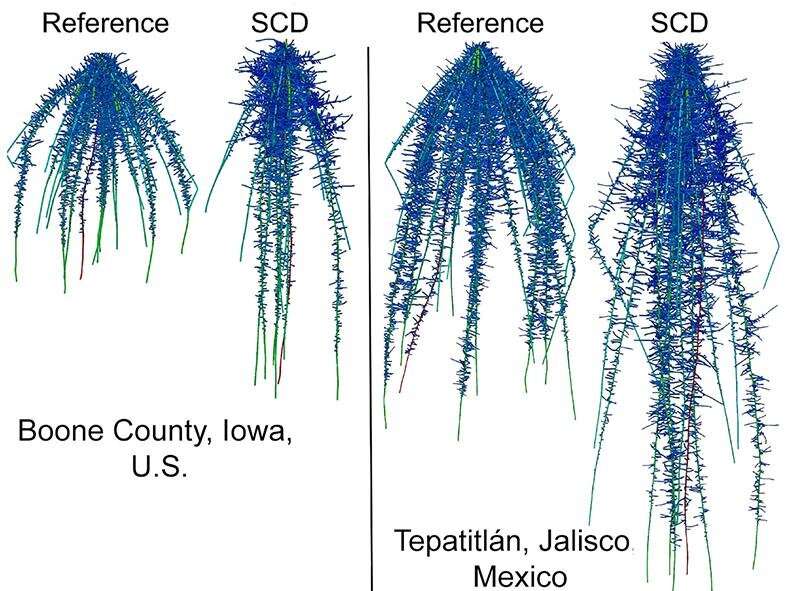Study shows 'steep, cheap and deep' roots help corn plants deal with drought

Rarely in nature does less turn out to be more. But that's the case when it comes to the roots of corn dealing with drought conditions, according to a Penn State-led international team of researchers who discovered evidence of the benefits of a "parsimonious" root phenotype in a new study.
Parsimonius—defined as "unwilling to use resources; stingy or frugal"—is the perfect descriptor for the genetically determined traits that allow plants to achieve improved vegetative growth, according to the study's lead author Jonathan Lynch, distinguished professor of plant science, in the College of Agricultural Sciences. The parsimonious root strategy, he pointed out, consists of plants developing "steep, cheap and deep roots."
"Steep" refers to architectural traits such as growth angle that makes roots head downward at a sharper angle, foraging deeper to acquire scarce water and nutrient resources. "Cheap" refers to the metabolic cost to the corn plant and includes traits such as making fewer roots and making roots with internal air spaces (aerenchyma) to reduce the number of living cells.
Plants expressing the parsimonious root phenotype actually grow fewer roots, Lynch explained. This ensures that the few roots that are produced have adequate resources to grow deep into the soil, which is especially important under drought stress. Hence the cheap, steep and deep characterization.
As an added bonus, the parsimonious root phenotype allows the plants to store, or sequester, more atmospheric carbon deeper in the soil where it will stay for long periods, Lynch noted.
"That's an important consideration with climate change expected to increase the frequency and severity of drought stress in the future," he said. "We believe crops can be made more resistant to drought and better able to sequester atmospheric carbon in the soil by plant breeders selecting appropriate root phenotypes."
To test their hypotheses, the researchers used an open-source, functional-structural plant/soil simulation model called OpenSimRoot—a powerful tool developed at Penn State over the last three decades—which enabled them to explicitly simulate the geometry of roots and soil properties in three dimensions over time.
In the study, the researchers tested the capacities of several variants of the steep, cheap and deep ideotype against a reference root phenotype of corn under rainfed and drought conditions in three distinct corn-producing environments. To accurately mimic the rainfed corn agrosystem, actual soil and climate datasets for the three different corn-growing locations were used: Boone County, Iowa, U.S.; Zaria Kaduna, Nigeria; and Tepatitlán, Jalisco, Mexico.
In findings recently published in Frontiers in Plant Science, the researchers reported that in all environments where plants are subjected to drought stress, the steep, cheap and deep phenotype lead to greater shoot biomass after 42 days of growth. As an additional advantage, they discovered, the amount of carbon deposited below two feet in the soil is twice as great for the steep, cheap and deep phenotype as for the reference phenotype in five out of six simulated environments.
Under simulated drought conditions, the steep, cheap and deep phenotypes differed from the reference phenotype in several important ways that would boost the plant's performance and survival. The "steep, cheap and deep" phenotypes produced about half the number of shallow axial roots; the angles of all roots were, on average, 20 degrees steeper compared to the reference phenotypes; the lateral root branching density (a measure of drought tolerance in which lower is better) was reduced by 50%; and the aerenchyma volume (root tissues containing enlarged gas spaces for transport of water and nutrients) was increased from 20% to 40%.
Because corn is a primary crop in the U.S. and is an important food-security crop in Africa and Latin America, and because drought is already a major limitation to global crop production and is intensifying as a result of global climate change, the findings of this research are important, Lynch suggested, adding that the findings point the way toward the development of more resilient crops.
"We believe that crop growth and deep soil carbon sequestration can be improved by breeding corn plants with fewer axial roots, reduced lateral root branching density and more aerenchyma formation," Lynch said. "This research yielded information that corn breeders can use to develop better drought tolerance by selecting for plants that have the cheap, steep and deep root phenotype, with fewer actual roots."
More information: Ernst D. Schäfer et al, In silico evidence for the utility of parsimonious root phenotypes for improved vegetative growth and carbon sequestration under drought, Frontiers in Plant Science (2022). DOI: 10.3389/fpls.2022.1010165
Journal information: Frontiers in Plant Science
Provided by Pennsylvania State University


















